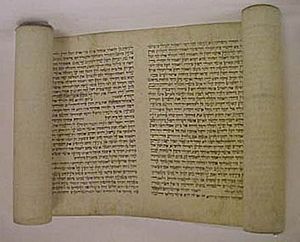Codex facts for kids

A codex (plural codices) is a book-like object with writing on it. On a codex there are separate pages, whereas a scroll is one continuous long document. The term is used for book-type objects written by hand, and includes books written on vellum or parchment.
The Romans developed the form from wooden writing tablets. The codex's gradual replacement of the scroll—the dominant book form in the ancient world—has been called the most important advance in book making before the invention of printing.
The codex transformed the shape of the book itself, and offered a form that lasted for centuries. The spread of the codex is often associated with the rise of Christianity, which adopted the format for use with the Bible early on. First described by the 1st-century AD Roman poet Martial, who praised its convenient use, the codex achieved numerical parity with the scroll around AD 300, and had completely replaced it throughout the now Christianised Greco-Roman world by the 6th century.
The codex provides considerable advantages over other book formats:
- Compactness
- Sturdiness
- Economic use of materials by using both sides (recto and verso)
- Ease of reference (A codex accommodates random access, as opposed to a scroll, which uses sequential access.)
The change from rolls to codices roughly coincides with the transition from papyrus to parchment as the preferred writing material. The codex began to replace the scroll almost as soon as it was invented. In Egypt, by the fifth century, the codex outnumbered the scroll by ten to one based on surviving examples. By the sixth century, the scroll had almost vanished as a medium for literature.
Related pages
Images for kids
-
Reproduction Roman-style wax tablet, from which the codex evolved.
-
Early medieval bookcase containing about ten codices depicted in the Codex Amiatinus (c. 700).
-
The Codex Mendoza, an Aztec codex from the early 16th century, showing the tribute obligations of particular towns.
-
The cover of the Carolingian gospel book, the Codex Aureus of St. Emmeram, produced ca. AD 870 at the Palace of Aachen, during the reign of Charles the Bald. Bayerische Staatsbibliothek, Munich.
-
Manuscript, Codex Manesse. Most manuscripts were ruled with horizontal lines that served as the baselines on which the text was entered.
See also
 In Spanish: Códice para niños
In Spanish: Códice para niños








